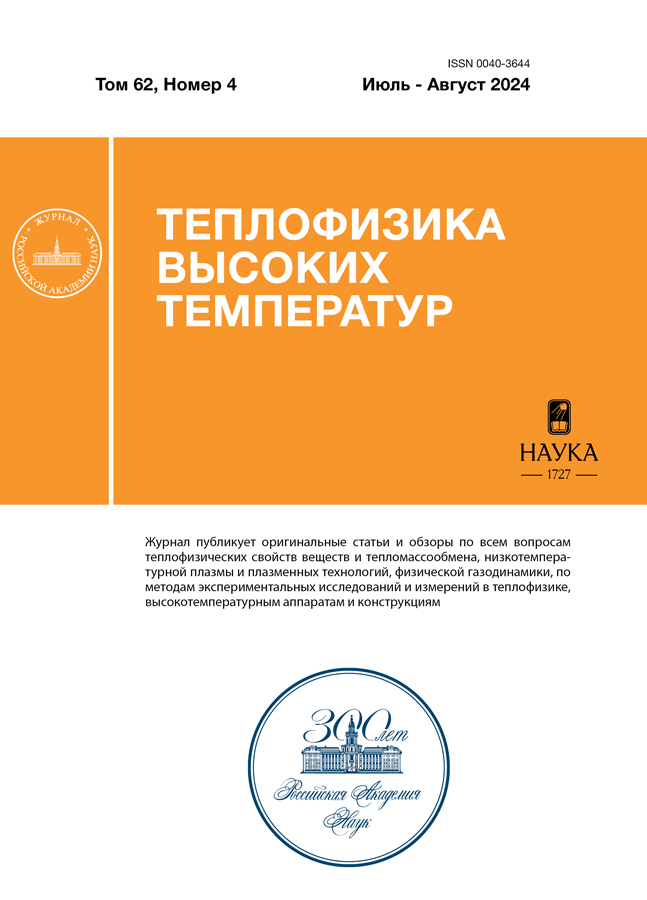Анализ RANS/ILES(i)-методом влияния турбулентности набегающего потока на течение в сверхзвуковом воздухозаборнике. Различные режимы работы воздухозаборника
- Autores: Жигалкин А.С.1, Любимов Д.А.1
-
Afiliações:
- ФАУ «Центральный институт авиационного моторостроения им. П.И. Баранова»
- Edição: Volume 62, Nº 4 (2024)
- Páginas: 544-557
- Seção: Heat and Mass Transfer and Physical Gasdynamics
- URL: https://rjdentistry.com/0040-3644/article/view/652995
- DOI: https://doi.org/10.31857/S0040364424040096
- ID: 652995
Citar
Texto integral
Resumo
С помощью комбинированного RANS/ILES(i)-метода проведены расчеты модельного сверхзвукового воздухозаборника смешанного сжатия. Расчеты проводились на блочно-структурированной сетке, содержащей 9 × 106 ячеек, при различных уровнях турбулентности набегающего потока и дросселирования воздухозаборника. Турбулентность задавалась путем добавления на входной границе однородного изотропного поля пульсаций скорости, сгенерированного с помощью метода синтетических вихрей. Для различных параметров турбулентности набегающего потока получены зависимости от коэффициента расхода осредненных в выходном сечении воздухозаборника коэффициента сохранения полного давления, статического давления, интенсивностей пульсаций давления и скорости, а также других параметров течения. Проанализировано влияние масштабов турбулентных вихрей на структуру мгновенного и осредненного полей скорости в канале воздухозаборника.
Texto integral
Sobre autores
А. Жигалкин
ФАУ «Центральный институт авиационного моторостроения им. П.И. Баранова»
Autor responsável pela correspondência
Email: aszhigalkin@ciam.ru
Rússia, Москва
Д. Любимов
ФАУ «Центральный институт авиационного моторостроения им. П.И. Баранова»
Email: dalyubimov@ciam.ru
Rússia, Москва
Bibliografia
- Любимов Д.А., Честных А.О. Исследование RANS/ILES-методом течения в высокоскоростном воздухозаборнике смешанного сжатия на различных режимах работы // ТВТ. 2018. Т. 56. № 5. С. 729.
- Любимов Д.А., Потехина И.В. Исследование нестационарных режимов работы сверхзвукового воздухозаборника RANS/ILES-методом // ТВТ. 2016. Т. 54. № 5. С. 784.
- Johnson J.S. The Effects of Freestream Turbulence on Serpentine Diffuser Distortion Patterns. Thesis Master of Science. Provo: Brigham Young University, 2012. 126 p.
- Rademakers R.P.M., Pohl A., Brehm S., Niehuis R. Influence of Varying Free-stream Turbulence on s-duct Aerodynamics // Proc. 12th Europ. Conf. Turbomachinery Fluid Dynamics & Thermodynamics ETC12. Stockholm, 2017.
- Hoffman J.A. Effects of Free-Stream Turbulence on Diffuser Performance // J. Fluids Eng. 1981. V. 103. P. 385.
- Аюпов Р.Ш., Бендерский Л.А., Любимов Д.А. Исследование RANS/ILES-методом влияния неоднородности температуры набегающего потока на пульсации давления в канале воздухозаборника // Мат. моделирование. 2019. Т. 31. № 10. С. 35.
- Любимов Д.А. Анализ RANS/ILES-методом влияния переменной теплоемкости на характеристики пульсаций давления в высокоскоростном воздухозаборнике // Мат. моделирование. 2019. Т. 31. № 10. С. 72.
- Жигалкин А.С., Любимов Д.А. Анализ RANS/ILES-методом влияния турбулентности набегающего потока на течение в сверхзвуковом воздухозаборнике. Оценка диссипативных свойств разностной схемы на примере моделирования распада однородной изотропной турбулентности в рамках ILES // ТВТ. 2022. Т. 60. № 1. С. 63.
- Trapier S., Duveau P., Sébastien Deck S. Experimental Study of Supersonic Inlet Buzz // AIAA J. 2006. V. 44. № 10. P. 2354.
- Jarrin N. Synthetic Inflow Boundary Conditions for the Numerical Simulation of Turbulence. Th. Ph. D. Manchester: University of Manchester, 2008. 258 p.
- Абрамович Г.Н. Прикладная газовая динамика. В 2 ч. Ч. 1: Учеб. руководство: для втузов. 5-е изд., перераб. и доп. М.: Наука; Гл. ред. физ.-мат. лит., 1991. 600 с.
- Теория авиационных двигателей. Ч. 1. Учеб. для вузов ВВС / Под ред. Нечаева Ю.Н. М.: Изд-во ВВИА им. проф. Н.Е. Жуковского, 2005. 366 с.
- Rhyne R.H., Steiner R. Power Spectral Measurement of Atmospheric Turbulence in Severe Storms and Cumulus Clouds: NASA Technical Note. Washington, DC: NASA, 1964.
- Guissart A., Romblad J., Nemitz T., Tropea C. Small-Scale Atmospheric Turbulence and Its Impact on Laminar-to-turbulent Transition // AIAA J. 2021. V. 59. № 9. P. 1.
- Tangermann E., Klein M. Numerical Simulation of Laminar Separation on a NACA0018 Airfoil in Freestream Turbulence // AIAA Scitech Forum. Orlando, 2020.
- Sheih C.M., Tennekes H., Lumley J.L. Airborne Hot-wire Measurements of the Small-scale Structure of Atmospheric Turbulence // Phys. Fluids. 1971. V. 14. № 2. P. 201.
- Pope S. Turbulent Flows. Cambridge: Cambridge University Press, 2000. 771 p.
- Любимов Д.А. Анализ RANS/ILES-методом влияния дросселирования и системы слива на спектральные характеристики пульсаций давления в спаренном сверхзвуковом воздухозаборнике. В кн.: Вычислительный эксперимент в аэроакустике и аэродинамике. Сб. тез. 9-й рос. конф. М.: ИПМ им. Келдыша РАН, 2022. С. 211.
Arquivos suplementares























